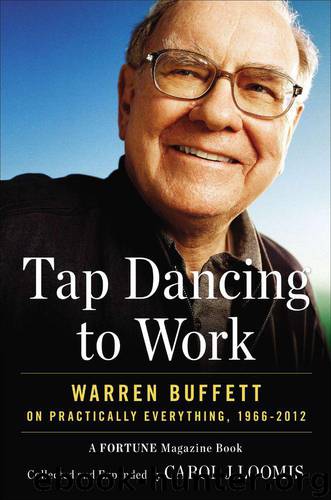Tap Dancing to Work: Warren Buffett on Practically Everything, 1966-2012: A Fortune Magazine Book by Carol J. Loomis

Author:Carol J. Loomis [Loomis, Carol J.]
Language: eng
Format: mobi
ISBN: 9781101601501
Publisher: Penguin Group US
Published: 2012-11-20T14:00:00+00:00
November 22, 1999
A Buffett speech that Carol Loomis converted into an article
Warren Buffett almost never talks publicly about the general level of stock prices—neither in his famed annual report nor at Berkshire’s thronged annual meetings nor in the rare speeches he gives. But in the last half of 1999, on four occasions, Buffett did step up to that subject, laying out his opinions, in ways both analytical and creative, about the long-term future for stocks. I heard the last of those talks, given in September to a group of Buffett’s friends, and also watched a videotape of the first speech, given in July at Allen & Co.’s Sun Valley, Idaho, bash for business leaders. From those extemporaneous talks (the first made with the Dow Jones industrial average at 11,194), I distilled the following account of what Buffett said. Buffett reviewed it and weighed in with some clarifications.
Buffett’s central message is contained in the first words of this article: “Investors in stocks these days are expecting far too much.” As for the nascent Internet, whose promise swelled investors’ hopes, he proceeded to emphasize how few people got rich from two other transforming industries, auto and aviation.
In his speeches, Buffett certainly did not anticipate the low interest rates—Treasury bills that pay pennies, for example—prevailing currently. Neither was he quite as grim about stock market returns as reality has proved them to be.
But he was absolutely right in his general bearishness about the market, so much so that he says today, “I wouldn’t change a word of what I said.” He was speaking at a time when investors had grown used to average annual total returns of 12 percent on their holdings. He expected instead that 7 percent was a reasonable estimate as to what investors—before inflation—could earn annually in total returns over the seventeen years from 1999 to 2016 (the article explains why he selected that oddball number of years). And that was a gross figure, before the heavy transactional costs that investors bear—commissions, sales loads, and management fees, for example. After these costs, Buffett thought that a reasonable expectation for the return would be about 6 percent annually.
In lamentable fact, the total return of the Dow Industrials, compounded annually, was from the end of 1999 through mid-2012 only 3.32 percent. The comparable figure for the S&P 500 (which is not as dividend-heavy as the Dow and suffered much more than the Dow when the Internet bubble burst) was absolutely abysmal: 1.26 percent.
As this book is published, there are still four years to go, of course, before the seventeen years end. But they will have to deliver superb results if investors are to speed across the ground they’ve lost and end up with even a 6 percent annual total return.—CL
Investors in stocks these days are expecting far too much, and I’m going to explain why. That will inevitably set me to talking about the general stock market, a subject I’m usually unwilling to discuss. But I want to make one thing clear
Download
This site does not store any files on its server. We only index and link to content provided by other sites. Please contact the content providers to delete copyright contents if any and email us, we'll remove relevant links or contents immediately.
Crazy Rich Asians by Kevin Kwan(9132)
How to Bang a Billionaire by Alexis Hall(8041)
Giovanni's Room by James Baldwin(7122)
Little Fires Everywhere by Celeste Ng(7066)
Win Bigly by Scott Adams(7038)
Tease (Temptation Series Book 4) by Ella Frank(5559)
Pachinko by Min Jin Lee(5525)
The Fire Next Time by James Baldwin(5205)
The Perks of Being a Wallflower by Stephen Chbosky(4540)
China Rich Girlfriend by Kwan Kevin(4462)
Bluets by Maggie Nelson(4436)
First Position by Melissa Brayden(4394)
The Sympathizer by Viet Thanh Nguyen(4267)
Rich People Problems by Kevin Kwan(4225)
A Little Life (2015) by Hanya Yanagihara(4137)
Right Here, Right Now by Georgia Beers(4064)
Walking by Henry David Thoreau(3863)
Catherine Anderson - Comanche 03 by Indigo Blue(3536)
I'll Catch You by Farrah Rochon(3499)
